Incorporating the Results of Geological Disaster Ecological Risk Assessment into Spatial Policies for Ecological Functional Areas: Practice in the Qilian Mountains of China
Abstract
:1. Introduction
2. Materials and Methods
2.1. Study Area
2.2. Data Sources and Data Pre-Processing
2.3. Methodology
2.3.1. Hazard Calculation
2.3.2. Calculation of Ecosystem Vulnerability
2.3.3. Calculation of Ecosystem Exposure
3. Results
3.1. Hazard Prediction Results
3.2. Results of ERA
3.3. Spatial Patterns of Ecological Risk
3.4. Sources of Ecological Risk
4. Discussion
4.1. Spatial Policies for Addressing Ecological Risks of Geological Disasters
4.2. Advantages of the Technical Framework Proposed in This Study
4.3. Limitations and Prospects
5. Conclusions
Author Contributions
Funding
Institutional Review Board Statement
Informed Consent Statement
Data Availability Statement
Conflicts of Interest
References
- Ju, H.; Niu, C.; Zhang, S.; Jiang, W.; Zhang, Z.; Zhang, X.; Yang, Z.; Cui, Y. Spatiotemporal patterns and modifiable areal unit problems of the landscape ecological risk in coastal areas: A case study of the Shandong Peninsula, China. J. Clean. Prod. 2021, 310, 127522. [Google Scholar] [CrossRef]
- Kapustka, L.A.; Galbraith, H.; Luxon, M.; Yocum, J. Using landscape ecology to focus ecological risk assessment and guide risk management decision-making. Toxicol. Ind. Health 2001, 17, 236–246. [Google Scholar] [CrossRef] [PubMed]
- Ran, P.; Hu, S.; Frazier, A.E.; Qu, S.; Yu, D.; Tong, L. Exploring changes in landscape ecological risk in the Yangtze River Economic Belt from a spatiotemporal perspective. Ecol. Indic. 2022, 137, 108744. [Google Scholar] [CrossRef]
- Formenti, S.; Peace, A.; Eyles, C.; Lee, R.; Waldron, J.W. Fractures in the Niagara Escarpment in Ontario, Canada: Distribution, connectivity, and geohazard implications. Geol. Mag. 2022, 159, 1936–1951. [Google Scholar] [CrossRef]
- Liu, S.; Yin, Y.; Liu, X.; Cheng, F.; Yang, J.; Li, J.; Dong, S.; Zhu, A. Ecosystem Services and landscape change associated with plantation expansion in a tropical rainforest region of Southwest China. Ecol. Model. 2017, 353, 129–138. [Google Scholar] [CrossRef]
- Fan, X.; Rong, Y.; Tian, C.; Ou, S.; Li, J.; Shi, H.; Qin, Y.; He, J.; Huang, C. Construction of an Ecological Security Pattern in an Urban–Lake Symbiosis Area: A Case Study of Hefei Metropolitan Area. Remote Sens. 2022, 14, 2498. [Google Scholar] [CrossRef]
- Zheng, Q.; Lyu, H.M.; Zhou, A.; Shen, S.L. Risk assessment of geohazards along Cheng-Kun railway using fuzzy AHP incorporated into GIS. Geomatics. Geomat. Nat. Hazards Risk 2021, 12, 1508–1531. [Google Scholar] [CrossRef]
- Arnous, M.O.; Green, D.R. GIS and remote sensing as tools for conducting geo-hazards risk assessment along Gulf of Aqaba coastal zone, Egypt. J. Coast. Conserv. 2011, 15, 457–475. [Google Scholar] [CrossRef]
- Wen, H.J.; Xie, P.; Xiao, P.; Hu, D.P. Rapid susceptibility mapping of earthquake-triggered slope geohazards in Lushan County by combining remote sensing with the AHP model developed for the Wenchuan earthquake. Bull. Eng. Geol. Environ. 2017, 76, 909–921. [Google Scholar] [CrossRef]
- Leuven, R.S.; Poudevigne, I. Riverine landscape dynamics and ecological risk assessment. Freshw. Biol. 2002, 47, 845–865. [Google Scholar] [CrossRef]
- Ratter, B.M. Surprise and uncertainty—Framing Regional Geohazards in the theory of complexity. Humanities 2013, 2, 1–19. [Google Scholar] [CrossRef]
- Gao, M.; Hu, Y.; Bai, Y. Construction of ecological security pattern in national land space from the perspective of the community of life in mountain, water, forest, field, lake and grass: A case study in Guangxi Hechi, China. Ecol. Indic. 2022, 139, 108867. [Google Scholar] [CrossRef]
- Lai, Y.; Huang, G.; Chen, S.; Lin, S.; Lin, W.; Lyu, J. Land Use Dynamics and Optimization from 2000 to 2020 in East Guangdong Province, China. Sustainability 2021, 13, 3473. [Google Scholar] [CrossRef]
- Huang, S.; Li, X.; Wang, Y. A New model of geo-environmental impact assessment of mining: A multiple-criteria assessment method integrating Fuzzy-AHP with fuzzy synthetic ranking. Environ. Earth Sci. 2012, 66, 275–284. [Google Scholar] [CrossRef]
- He, F.; Liu, C.X.; Liu, H.J. Integration and Fusion of Geologic Hazard Data under Deep Learning and Big Data Analysis Technology. Complexity 2021, 2021, 2871770. [Google Scholar] [CrossRef]
- Fang, J.P.; Quan, H.C. Risk Analysis of Debris Flow hazardsin Yanbian Prefecture Based on Information Quantity Method. IOP Conf. Ser. Earth Environ. Sci. 2019, 300, 022051. [Google Scholar] [CrossRef]
- Van Den Eeckhaut, M.; Hervás, J. State of the art of national landslide databases in Europe and their potential for assessing landslide susceptibility, hazard and risk. Geomorphology 2012, 139, 545–558. [Google Scholar] [CrossRef]
- Zhao, J.; Zhang, Q.; Wang, D.; Wu, W.; Yuan, R. Machine learning-based evaluation of susceptibility to geological hazards in the Hengduan mountains region, China. Int. J. Disaster Risk Sci. 2022, 13, 305–316. [Google Scholar] [CrossRef]
- Zou, Q.; Jiang, H.; Cui, P.; Zhou, B.; Jiang, Y.; Qin, M.; Liu, Y.; Li, C. A new approach to assess landslide susceptibility based on slope failure mechanisms. Catena 2021, 204, 105388. [Google Scholar] [CrossRef]
- Achour, Y.; Saidani, Z.; Touati, R.; Pham, Q.B.; Pal, S.C.; Mustafa, F.; Balik Sanli, F. Assessing landslide susceptibility using a machine learning-based approach to achieving land degradation neutrality. Environ. Earth Sci. 2021, 80, 575. [Google Scholar] [CrossRef]
- Ma, Z.J.; Mei, G. Deep learning for geological hazards analysis: Data, models, applications, and opportunities. Earth-Sci. Rev. 2021, 223, 103858. [Google Scholar] [CrossRef]
- Dikshit, A.; Pradhan, B.; Alamri, A.M. Pathways and challenges of the application of artificial intelligence to geohazards modelling. Gondwana Res. 2021, 100, 290–301. [Google Scholar] [CrossRef]
- Pavlova, I.; Makarigakis, A.; Depret, T.; Jomelli, V. Global overview of the geological hazard exposure and disaster risk awareness at world heritage sites. J. Cult. Herit. 2017, 28, 151–157. [Google Scholar] [CrossRef]
- Lin, J.H.; Chen, W.H.; Qi, X.H.; Hou, H.R. Risk assessment and its influencing factors analysis of geological hazards in typical mountain environment. J. Clean. Prod. 2021, 309, 127077. [Google Scholar] [CrossRef]
- Quanyuan, W.; Jiewu, P.; Shanzhong, Q.; Yiping, L.; Congcong, H.; Tingxiang, L.; Limei, H. Impacts of coal mining subsidence on the surface landscape in Longkou city, Shandong Province of China. Environ. Earth Sci. 2009, 59, 783–791. [Google Scholar] [CrossRef]
- Duan, Y.; Di, B.; Ustin, S.L.; Xu, C.; Xie, Q.; Wu, S.; Li, J.; Zhang, R. Changes in ecosystem services in a montane landscape impacted by major earthquakes: A case study in Wenchuan earthquake-affected area, China. Ecol. Indic. 2021, 126, 107683. [Google Scholar] [CrossRef]
- Wu, J.; Zhu, Q.; Qiao, N.; Wang, Z.; Sha, W.; Luo, K.; Wang, H.; Feng, Z. Ecological risk assessment of coal mine area based on “source-sink” landscape theory–A case study of Pingshuo mining area. J. Clean. Prod. 2021, 295, 126371. [Google Scholar] [CrossRef]
- Zhang, M.; Bao, Y.; Xu, J.; Han, A.; Liu, X.; Zhang, J.; Tong, Z. Ecological security evaluation and ecological regulation approach of East-Liao River basin based on ecological function area. Ecol. Indic. 2021, 132, 108255. [Google Scholar] [CrossRef]
- Hong, W.; Jiang, R.; Yang, C.; Zhang, F.; Su, M.; Liao, Q. Establishing an ecological vulnerability assessment indicator system for spatial recognition and management of ecologically vulnerable areas in highly urbanized regions: A case study of Shenzhen, China. Ecol. Indic. 2016, 69, 540–547. [Google Scholar] [CrossRef]
- Li, S.; Zhao, X.; Pu, J.; Miao, P.; Wang, Q.; Tan, K. Optimize and control territorial spatial functional areas to improve the ecological stability and total environment in karst areas of Southwest China. Land Use Policy 2021, 100, 104940. [Google Scholar] [CrossRef]
- Chen, D.; Pan, Y.; Jin, X.; Du, H.; Li, M.; Jiang, P. The delineation of ecological redline area for catchment sustainable management from the perspective of ecosystem services and social needs: A case study of the Xiangjiang watershed, China. Ecol. Indic. 2021, 121, 107130. [Google Scholar] [CrossRef]
- Tian, H.; Yang, T.; Liu, Q. Climate change and glacier area shrinkage in the Qilian mountains, China, from 1956 to 2010. Ann. Glaciol. 2014, 55, 187–197. [Google Scholar] [CrossRef]
- Han, Z.; Song, W.; Deng, X. Responses of Ecosystem Service to Land Use Change in Qinghai Province. Energies 2016, 9, 303. [Google Scholar] [CrossRef]
- Liu, J.; Xu, X.; Shao, Q. Grassland degradation in the “Three-River Headwaters” region, Qinghai Province. J. Geogr. Sci. 2008, 18, 259–273. [Google Scholar] [CrossRef]
- Bai, A.J.; Zhu, K.X.; Guan, Q. Characteristics of Meteorological Geology Disasters and Rainfall in Qinghai Plateau. Plateau Mt. Meteorol. Res. 2021, 41, 119–124. [Google Scholar] [CrossRef]
- Zongxing, L.; Qi, F.; Zongjie, L.; Xufeng, W.; Juan, G.; Baijuan, Z.; Yuchen, L.; Xiaohong, D.; Jian, X.; Wende, G.; et al. Reversing conflict between humans and the environment-The experience in the Qilian Mountains. Renew. Sustain. Energy Rev. 2021, 148, 111333. [Google Scholar] [CrossRef]
- Chuanyan, Z.; Zhongren, N.; Guodong, C. Methods for modelling of temporal and spatial distribution of air temperature at landscape scale in the southern Qilian mountains, China. Ecol. Model. 2005, 189, 209–220. [Google Scholar] [CrossRef]
- Sun, F.; Lyu, Y.; Fu, B.; Hu, J. Hydrological services by mountain ecosystems in Qilian Mountain of China: A review. Chin. Geogr. Sci. 2016, 26, 174–187. [Google Scholar] [CrossRef]
- Deng, S.F.; Yang, T.B.; Zeng, B.; Zhu, X.F.; Xu, H.J. Vegetation cover variation in the Qilian Mountains and its response to climate change in 2000–2011. J. Mt. Sci. 2013, 10, 1050–1062. [Google Scholar] [CrossRef]
- Liu, Q.; Yang, Z.; Shi, H.; Wang, Z. Ecological risk assessment of geohazards in Natural World Heritage Sites: An empirical analysis of Bogda, Tianshan. Open Geosci. 2019, 11, 327–340. [Google Scholar] [CrossRef]
- Huang, W.; Ding, M.; Li, Z.; Zhuang, J.; Yang, J.; Li, X.; Meng, L.; Zhang, H.; Dong, Y. An Efficient User-Friendly Integration Tool for Landslide Susceptibility Mapping Based on Support Vector Machines: SVM-LSM Toolbox. Remote Sens. 2022, 14, 3408. [Google Scholar] [CrossRef]
- Cao, J.; Zhang, Z.; Du, J.; Zhang, L.; Song, Y.; Sun, G. Multi-geohazards susceptibility mapping based on machine learning—A case study in Jiuzhaigou, China. Nat. Hazards 2020, 102, 851–871. [Google Scholar] [CrossRef]
- Huang, Y.; Zhao, L. Review on landslide susceptibility mapping using support vector machines. Catena 2018, 165, 520–529. [Google Scholar] [CrossRef]
- Xie, G.D.; Zhang, C.X.; Zhang, L.M.; Chen, W.H.; Li, S.M. Improvement of the evaluation method for ecosystem service value based on per unit area. J. Nat. Resour 2015, 30, 1243. [Google Scholar]
- Hu, C.; Wang, Z.; Huang, G.; Ding, Y. Construction, Evaluation, and Optimization of a Regional Ecological Security Pattern Based on MSPA–Circuit Theory Approach. Int. J. Environ. Res. Public Health 2022, 19, 16184. [Google Scholar] [CrossRef] [PubMed]
- Wang, S.; Wu, M.; Hu, M.; Xia, B. Integrating ecosystem services and landscape connectivity into the optimization of ecological security pattern: A case study of the Pearl River Delta, China. Environ. Sci. Pollut. Res. 2022, 29, 76051–76065. [Google Scholar] [CrossRef] [PubMed]
- Grêt-Regamey, A.; Weibel, B. Global assessment of mountain ecosystem services using earth observation data. Ecosyst. Serv. 2020, 46, 101213. [Google Scholar] [CrossRef]
- Brardinoni, F.; Grischott, R.; Kober, F.; Morelli, C.; Christl, M. Evaluating debris-flow and anthropogenic disturbance on 10Be concentration in mountain drainage basins: Implications for functional connectivity and denudation rates across time scales. Earth Surf. Process. Landf. 2020, 45, 3955–3974. [Google Scholar] [CrossRef]
- Abdullah, S.A.; Hezri, A.A. From forest landscape to agricultural landscape in the developing tropical country of Malaysia: Pattern, process, and their significance on policy. Environ. Manag. 2008, 42, 907–917. [Google Scholar] [CrossRef]
- Singh, K.; Byun, C.; Bux, F. Ecological restoration of degraded ecosystems in India: Science and practices. Ecol. Eng. 2022, 182, 106708. [Google Scholar] [CrossRef]
- Mir, M.; Maleki, S.; Rahdari, V. Ecosystem restoration and degradation monitoring using ecological indices. Int. J. Environ. Sci. Technol 2022, 20, 1713–1724. [Google Scholar] [CrossRef]

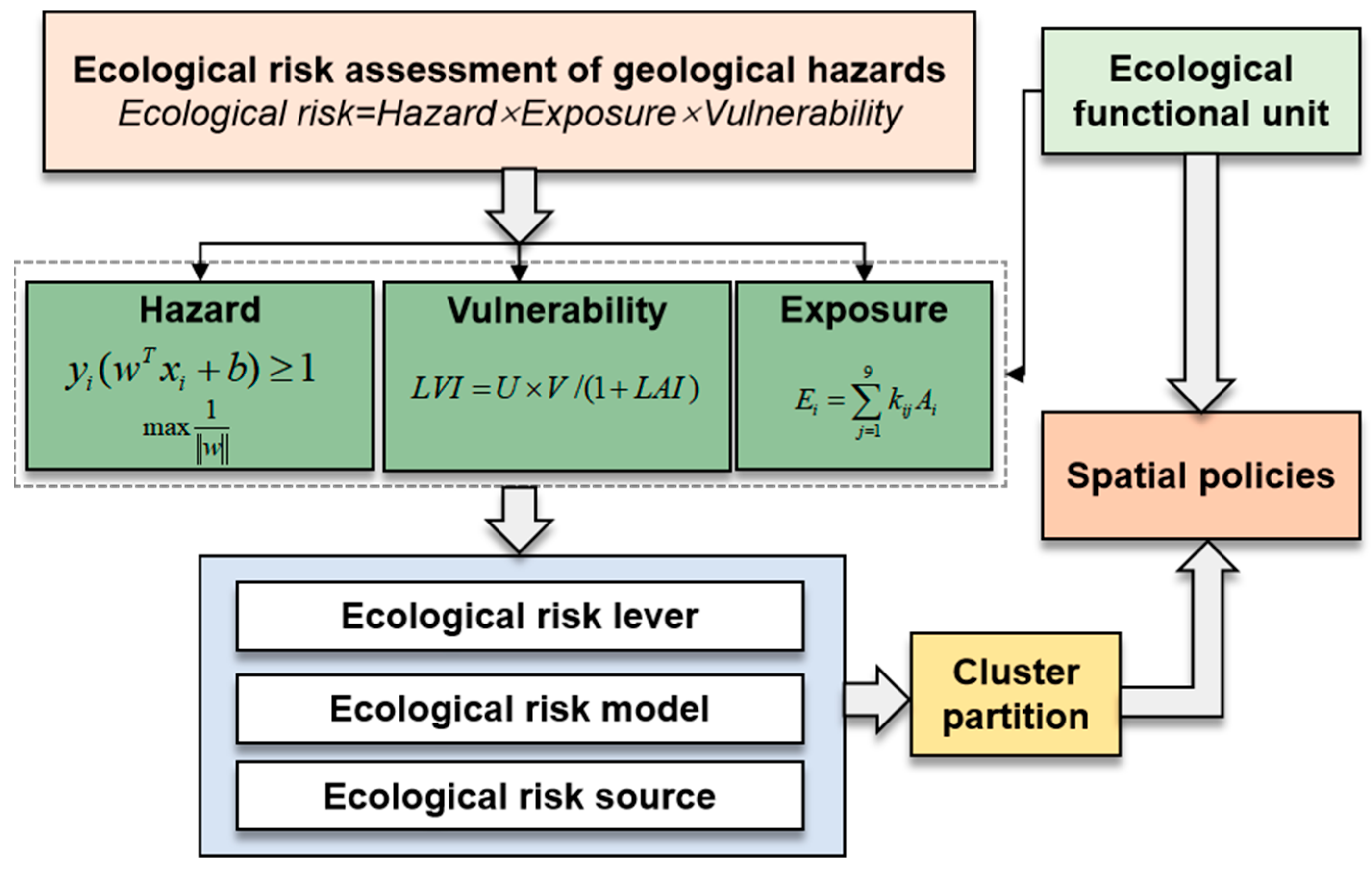
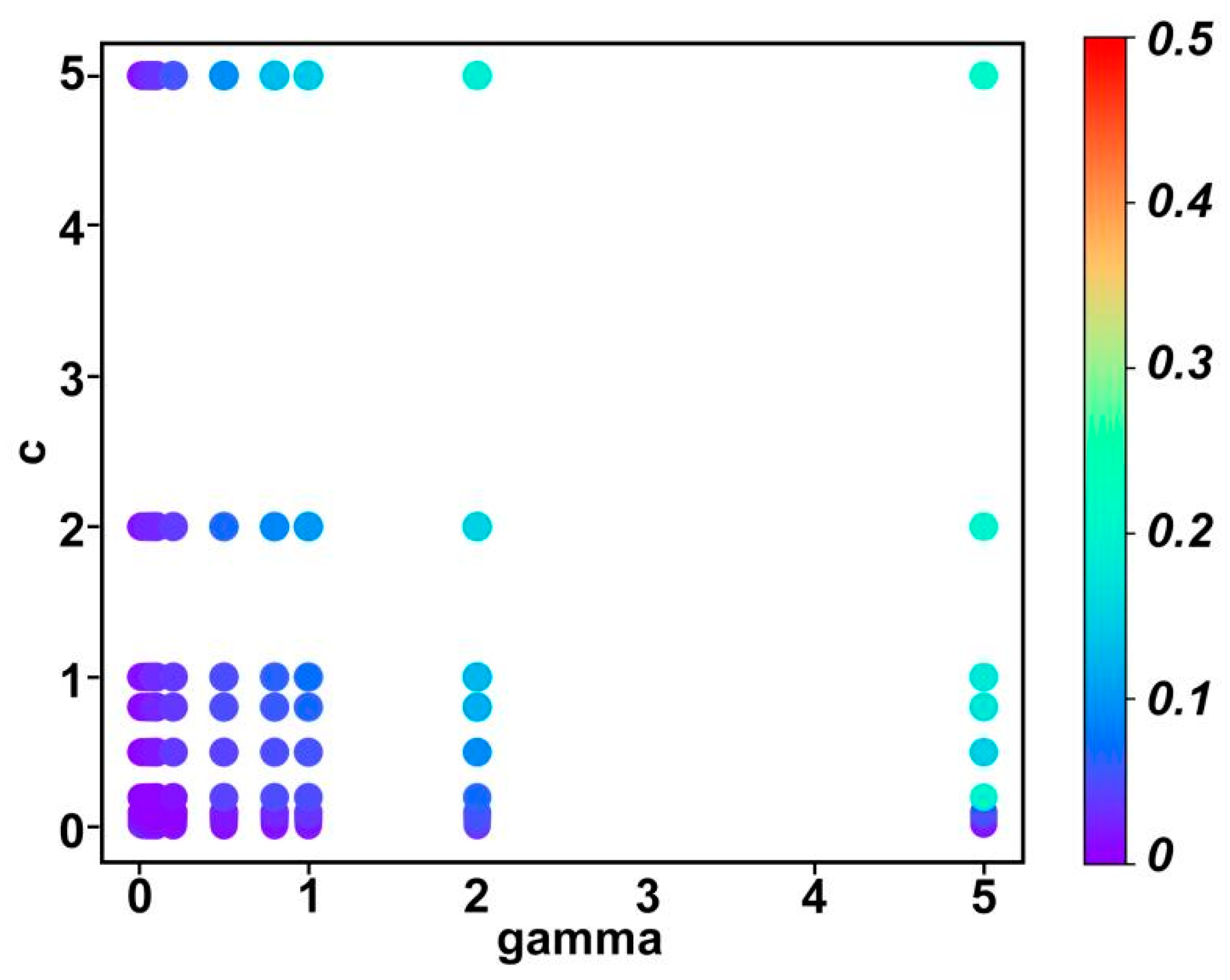
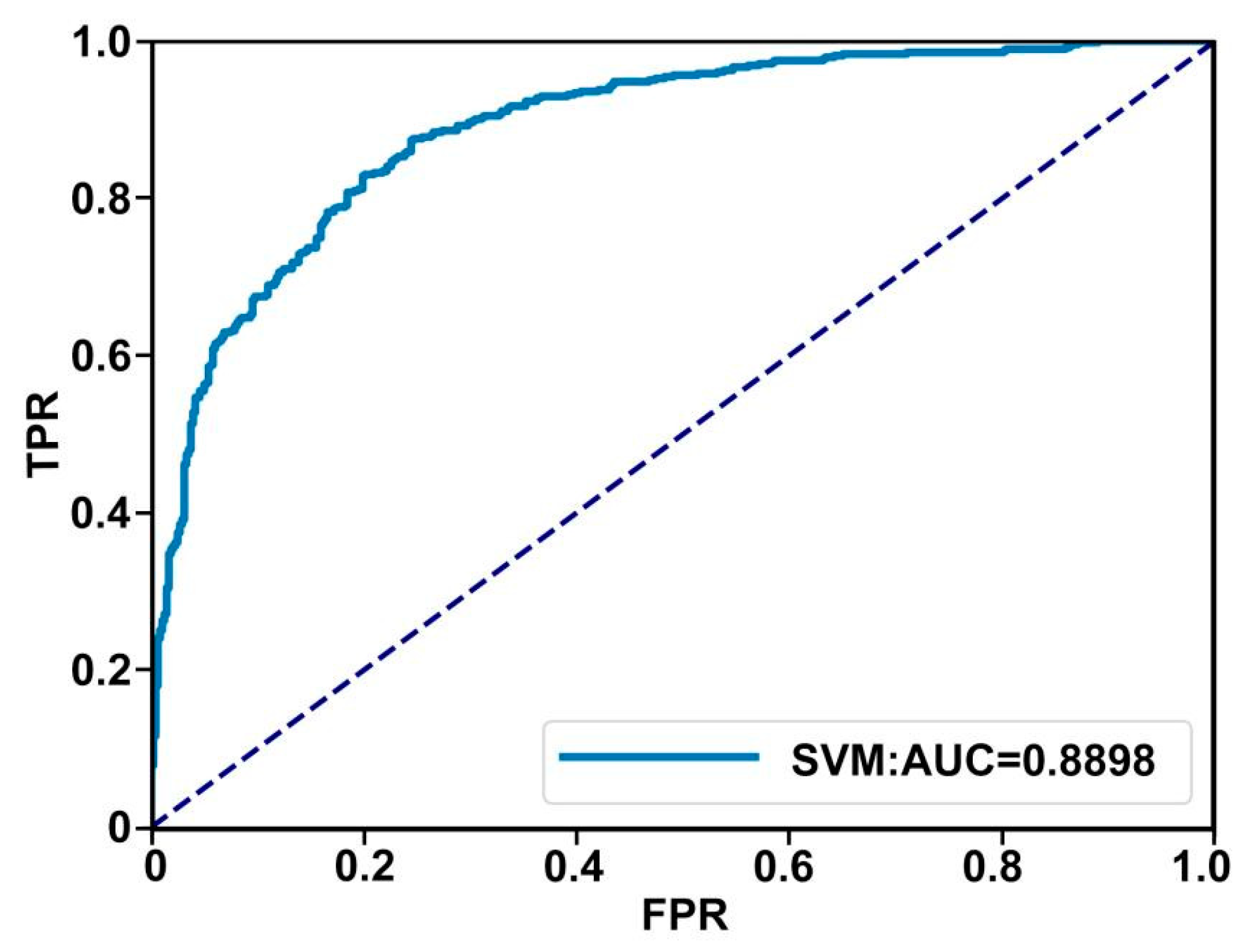


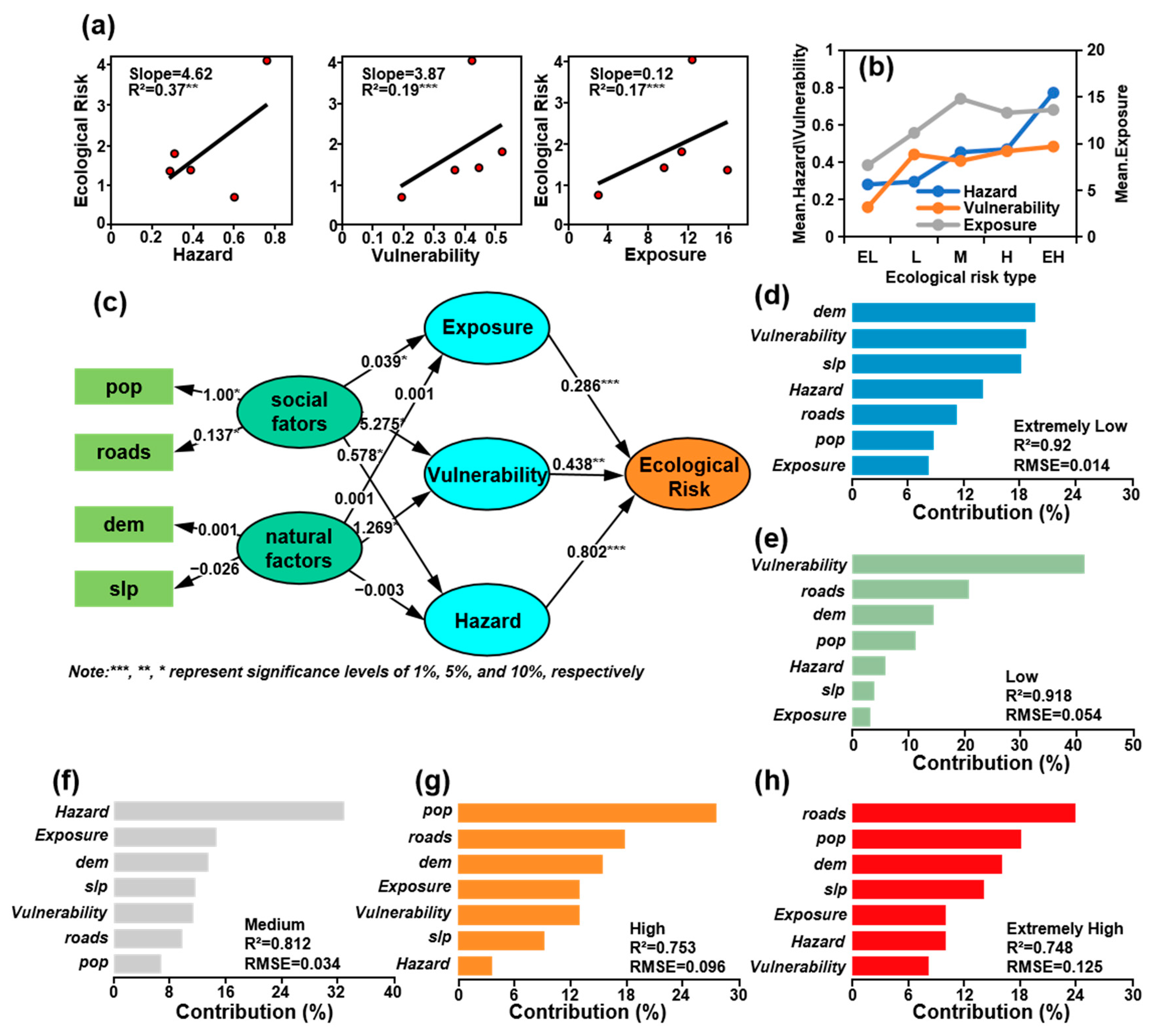
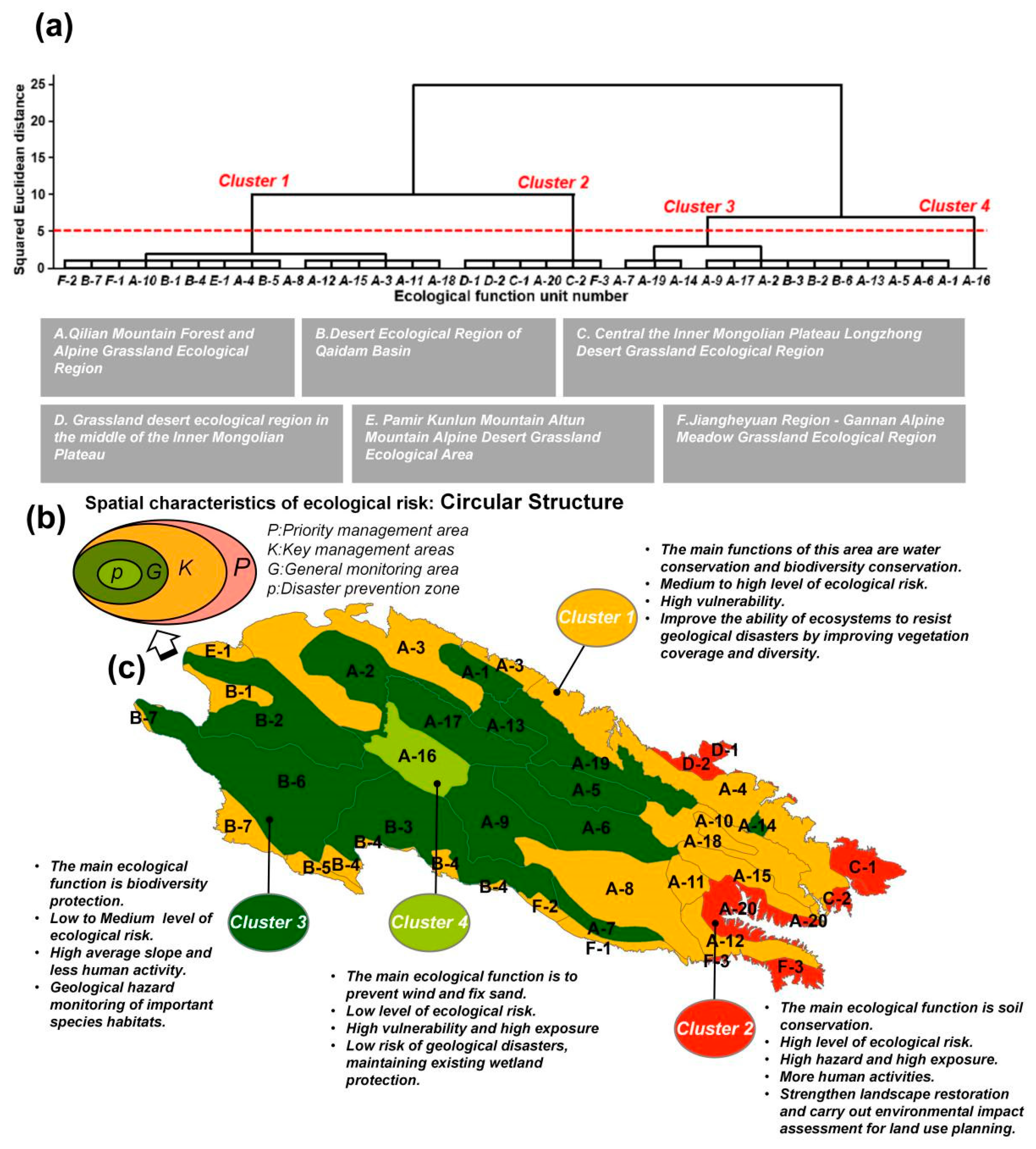
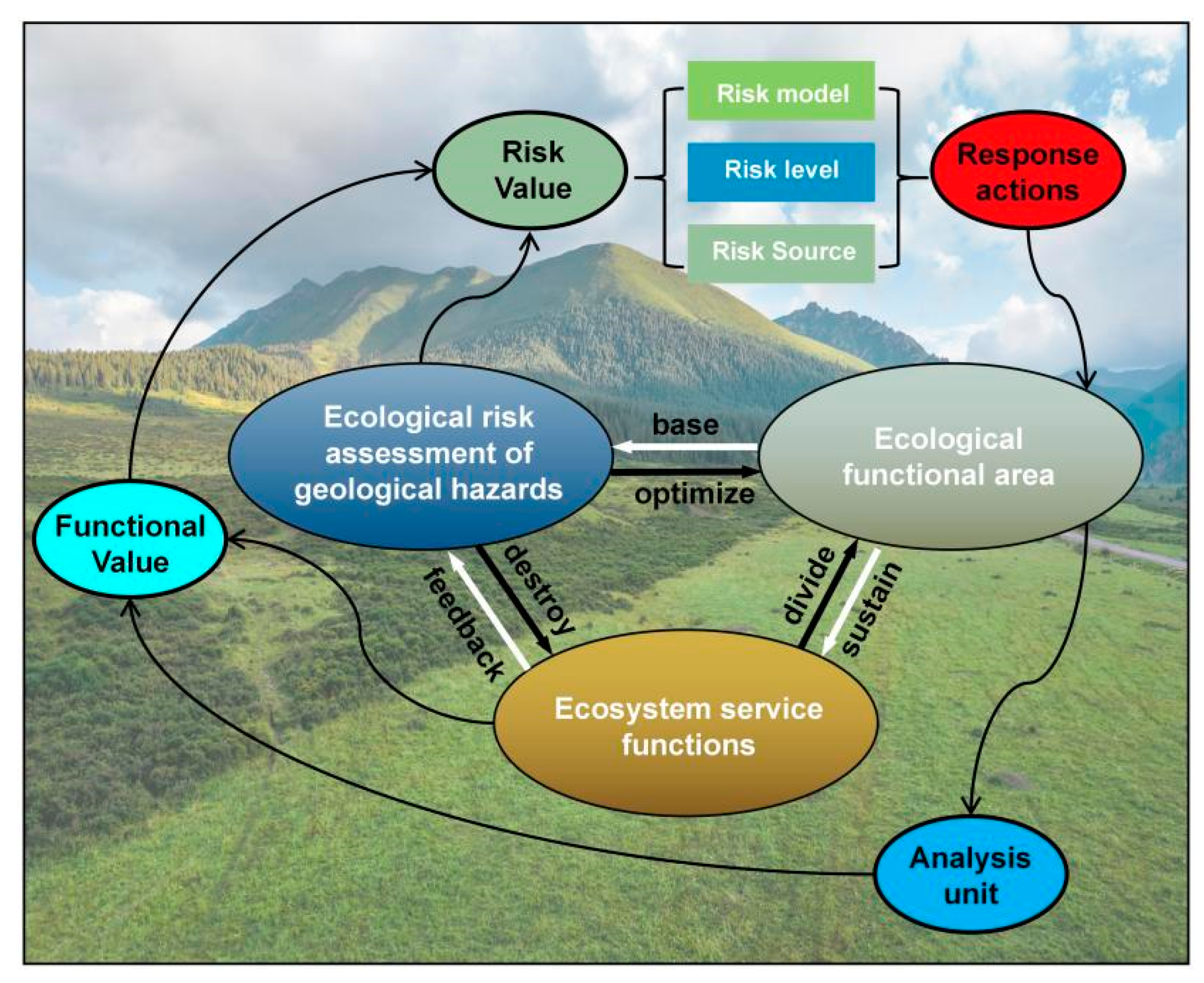
| Indicator | Calculation | Landscape Ecology Significance |
|---|---|---|
| Interference degree of landscape (U) | U = a × FN + b × FI + c × FD | The degree of landscape disturbance indicates the degree of loss in the area after being disturbed. Based on expert opinions, take values of 0.5, 0.3, and 0.2 for a, b, and c, respectively. |
| Fragmentation (FN) | The degree to which the landscape is fragmented and broken reflects the extent of human interference with the landscape to a certain extent. | |
| Isolation of landscape (FI) | Used to reveal the degree of separation of individual patches in landscape types. The higher the detachment of patches, the smaller their ability to resist risks, and the lower their landscape safety. | |
| Fractal dimension (FD) | The smaller the index value, the less likely it is to be interfered with by human activities, while the larger the index value, the more likely it is to be interfered with by human activities. | |
| Landscape vulnerability (V) | Experts knowledge acquired | Barren, Sonw/Ice, Water, Wetland, Grassland, Forest, Shrub, Cropland, and Impervious are divided into 9, 8, 7, 6, 5, 4, 3, 2, and 1, respectively. |
| Landscape adaptation index (LAI) | LAI = PRD + SHDI + SHEI | LAI is determined by referencing other people’s research and is composed of the patch richness index, Shannon diversity index, and Shannon evenness index. |
| Patch richness index (PRD) | PRD is the number of patches per unit area; it reflects the dispersion of patches in a landscape type. | |
| Shannon diversity index (SHDI) | Reflects the richness and complexity of the landscape. | |
| Shannon evenness index (SHEI) | Indicates the maximum possible diversity of a given landscape’s richness. Reflects the stability of the ecosystem. |
| Combination Pattern | Low Risk | Medium Risk | High Risk | |||
|---|---|---|---|---|---|---|
| Functional Unit/Number | Share/% | Functional Unit/Number | Share/% | Functional Unit/Number | Share/% | |
| Low hazard–low vulnerability–low exposure | 8 | 50 | 0 | 0 | 0 | 0 |
| Low hazard–low vulnerability–high exposure | 0 | 0 | 1 | 7.7 | 0 | 0 |
| Low hazard–high vulnerability–low exposure | 4 | 25 | 4 | 30.8 | 1 | 16.7 |
| Low hazard–high vulnerability–high exposure | 1 | 6.3 | 0 | 0 | 0 | 0 |
| High hazard–low vulnerability–low exposure | 3 | 18.8 | 2 | 15.4 | 0 | 0 |
| High hazard–high vulnerability–low exposure | 0 | 0 | 6 | 46.2 | 5 | 83.3 |
| Total | 16 | 100 | 13 | 100 | 6 | 100 |
Disclaimer/Publisher’s Note: The statements, opinions and data contained in all publications are solely those of the individual author(s) and contributor(s) and not of MDPI and/or the editor(s). MDPI and/or the editor(s) disclaim responsibility for any injury to people or property resulting from any ideas, methods, instructions or products referred to in the content. |
© 2024 by the authors. Licensee MDPI, Basel, Switzerland. This article is an open access article distributed under the terms and conditions of the Creative Commons Attribution (CC BY) license (https://creativecommons.org/licenses/by/4.0/).
Share and Cite
Long, X.; Xiang, Q.; Zhang, R.; Huang, H. Incorporating the Results of Geological Disaster Ecological Risk Assessment into Spatial Policies for Ecological Functional Areas: Practice in the Qilian Mountains of China. Sustainability 2024, 16, 2976. https://doi.org/10.3390/su16072976
Long X, Xiang Q, Zhang R, Huang H. Incorporating the Results of Geological Disaster Ecological Risk Assessment into Spatial Policies for Ecological Functional Areas: Practice in the Qilian Mountains of China. Sustainability. 2024; 16(7):2976. https://doi.org/10.3390/su16072976
Chicago/Turabian StyleLong, Xu, Qing Xiang, Rongguang Zhang, and Hong Huang. 2024. "Incorporating the Results of Geological Disaster Ecological Risk Assessment into Spatial Policies for Ecological Functional Areas: Practice in the Qilian Mountains of China" Sustainability 16, no. 7: 2976. https://doi.org/10.3390/su16072976





